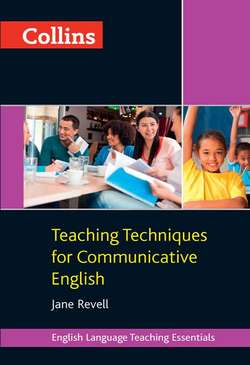Читать книгу Collins Teaching Techniques for Communicative English - Jane Revell - Страница 13
ОглавлениеChapter 2 Limbering up
2.1 Getting in the mood
In this chapter we shall be looking at activities for the classroom which encourage students to get to know – and trust – one another and which help them gradually build up their confidence. All of these ideas have actually been used with foreign learners – most of them with adults, and one or two of them with children – and they have worked successfully.
Activities involving simulation and role-play (see Chapter 4) require a certain amount of psychological preparation: there is a need to break the students in gently and gradually overcome any inhibitions that they may quite naturally feel.
Although most young children seem to take to role-play activities like ducks to water, some adult students who have never done anything quite like it, and many adolescent students, are less enthusiastic. They are afraid of being made to look silly in front of their fellow students, and exposed to their criticism. A teacher who rushes into this type of activity without adequate preparation exercises runs the risk of scaring their students off for good. Building up the students’ confidence, creating an atmosphere of trust (see 2.4 ‘Getting to know you games’ below), teaching the students to relax – all these things take time and demand exercises where the individuals in a class are working together, getting to know each other well. The activities in this chapter are designed to have this effect, and include games, group and pair exercises intended to loosen up the class and create a relaxed and harmonious atmosphere conducive to role-play activities. Even physical exercises are mentioned: they relax people physically and so make them less inhibited generally. The exercises described in this chapter should ideally be used over a period of time – one or two of them could be brought into every lesson.
2.2 Possible problems
Before describing the activities, I should like to mention two difficulties that can arise.
The first problem is a physical one: in classrooms with fixed desks all facing forwards in rows, group-work is difficult, and having people move around is even more difficult. If teaching is to be truly communicative then it almost goes without saying that the teacher should not be the focus of attention all the time but that the interaction should be general. Seating the students in a large circle is ideal as it means that every student is in contact with both the teacher and every other student, and a large space is left in the middle for activities that require a lot of room. I know that not all classrooms lend themselves to the circular layout, however, so we have to make the most of what we have.
The second problem is one of discipline, if the learners are not adults. This can be a very serious problem and often deters teachers from embarking on a noisy and potentially riotous activity! Three points should be mentioned here. Firstly, the physical grouping of the class is an important factor: the circular arrangement suggested above enables the teacher to be in eye contact with everyone and does seem to give them more control than other groupings. Also of prime importance is motivation: students who are interested in what is going on in the classroom and who find it relevant, realistic and fun will be less likely to cause trouble. Thirdly, the gradual build-up advocated in the last section should make it easier for all the members of a class to participate and to relate well to one another. This harmony tends to work against potentially disruptive students.
2.3 Dealing with mistakes
We have already mentioned the treatment of error (see ‘Accuracy versus fluency’ in Chapter 1) and the importance of focusing on fluency rather than accuracy in communicative language practice. The students will probably make quite a few mistakes, so what should a teacher do when, having vowed not to interfere, they hear a mistake that makes their hair stand on end?
There are ways of dealing with these ‘bad’ mistakes without disrupting the activity and alarming the student concerned.
Mario Rinvolucri advocates ‘hot correction’ in group work: he slips a piece of paper to the student with the correction written on it – feeling that if he leaves it until later the student will have forgotten what it was all about. Even this tends to be a little disruptive at first, although it is much less so with a group of students who are really used to the technique.
Teachers can also keep a note of any mistakes they hear, and go through them anonymously when the activity has finished, by writing them up on the board and inviting corrections from the whole class. If several students are making the same mistake, it is worth planning a follow-up lesson to deal with the point.
An option with a small group may be to record the activity in audio or video and play it back to the students. The playback is both enjoyable and profitable as it normally provokes a good deal of discussion. Students can make suggestions themselves as to what they should or might have said in those circumstances. (It is worthwhile teaching the students to use the equipment so that they are able to record themselves.)
